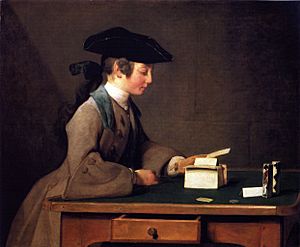The House of Cards facts for kids
The House of Cards is a famous oil painting created by the French artist Jean-Baptiste-Siméon-Chardin. He painted it around the year 1737. This artwork is about 60 centimeters tall and 72 centimeters wide (which is about 23.6 inches by 28.3 inches). Today, you can see it at the National Gallery in London, England. Chardin was known for painting everyday scenes of life, which were very popular with people from all walks of life in Paris.
Contents
About the Painting
This painting is called The House of Cards because it shows a young boy carefully building a tower out of playing cards. It's a quiet moment, showing how focused he is on his task. The boy in the painting is often thought to be the son of a French nobleman, and he looks very serious as he tries to balance the cards.
What Does the Painting Show?
The painting focuses on a young boy, dressed in nice clothes, sitting at a table. He is completely absorbed in building his card house. The light in the painting is soft, making the boy and his cards stand out. Chardin was very good at showing everyday objects and people in a way that felt real and calm. He often painted scenes that people could relate to, like children playing or people doing chores.
Who Was Jean-Baptiste-Siméon-Chardin?
Jean-Baptiste-Siméon-Chardin was a very important French painter who lived from 1699 to 1779. He is famous for his still-life paintings (pictures of objects like fruit or dishes) and his genre paintings (pictures of everyday life). Unlike some artists who painted grand historical scenes or portraits of kings, Chardin chose to paint simpler subjects. His work was loved because it showed ordinary life with great detail and a warm, gentle feeling. He was especially good at showing textures, like the fabric of clothes or the smoothness of a table.
Where Can You See It?
Today, The House of Cards is a treasured piece of art at the National Gallery in London. This museum is home to many famous paintings from different periods and artists around the world. Seeing the painting in person allows you to appreciate Chardin's skill and the quiet beauty of this everyday scene.


